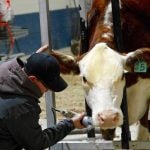Summertime, and the living is easy, as the old song goes, but heat can make living all too easy for blue-green algae in farm dugouts and ponds.
Temperatures in the high 20s and low 30s C last week in parts of Western Canada were ideal for algal growth.
The algae, also known as cyanobacteria, is natural in surface water, but some types produce toxins that can be dangerous to livestock and pets when ingested. High levels can cause illness or death.
“The most obvious sign would be rapid death syndrome, where their nervous system makes their lungs stop working,” Alberta Agriculture water specialist Shawn Elgert said about cyanobacteria’s effect on livestock.
Read Also

Trump cuts off trade talks with Canada
(Reuters) – U.S. President Donald Trump said on Thursday that all trade talks with Canada were terminated following what he…
“It’s more difficult to tell some of the other signs. That’s why it’s always good to treat cyanobacterial growth as if it has the potential to produce toxins and have a harmful effect. So take the conservative approach.”
Treatment options are available for blue-green algae blooms, but initial identification can be tricky. The first step is to identify the algae by speaking with an expert or having the water tested.
Elgert said there is anecdotal evidence that adding a type of blue dye to the water can inhibit growth.
If it’s a matter of treating blue-green algae already present, copper algacides, aluminum sulfate or hydrated lime are options.
“They are readily available. However, they can be difficult to apply, especially hydrated lime,” said Elgert. “It is caustic and one should be fully equipped with BPE (bioprocessing) equipment to protect themselves.
“Traditionally, a copper product has been used for treatment. They used to use copper sulfate, which is no longer registered for use in farm dugouts under the Pest Management Regulatory Agency. There are copper algacides in a liquid form … that are registered.”
Elgert said a little bit of product can usually go a long way, so learn how much to use before administering chemicals to water.
Water that is treated with a liquid copper product should not be used for up to one month. Copper causes the algae cells to break open, releasing toxins all at once and making the water particularly dangerous.
However, prevention of blue-green algae is always better than having to treat it, said Elgert.
Producers can reduce the chances of algal problems by keeping nutrients out of the water, planting buffer strips between the dugout and other parts of the farm and making steep slopes on the dugout.
“Aeration can help oxidize some of the nutrients out of the dugout,” said Elgert. “It’s not a magic bullet. It doesn’t cure all problems, but it is a good value for the money spent on a system.”
Fact sheets on blue-green algae and farm dugouts are available on the Alberta Agriculture website.















